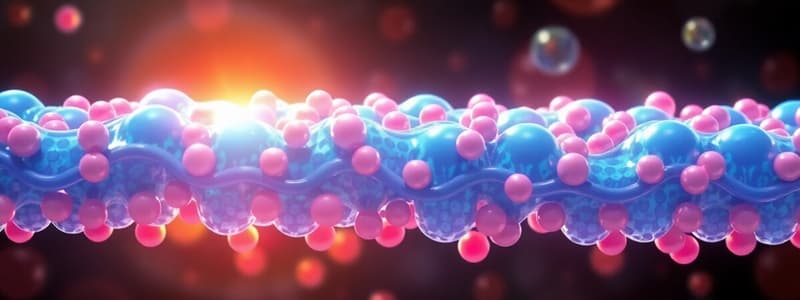Podcast
Questions and Answers
What role do carbohydrate groups play in integral proteins like bands 3 and 7?
What role do carbohydrate groups play in integral proteins like bands 3 and 7?
- They lock the orientation of the protein in the membrane. (correct)
- They increase the solubility of proteins in the cytoplasm.
- They enhance the electrical conductivity of the cell membrane.
- They facilitate the rotation of proteins within the membrane.
What is the primary protein structure that forms the erythrocyte cytoskeleton?
What is the primary protein structure that forms the erythrocyte cytoskeleton?
- Keratin
- Collagen
- Myosin
- Spectrin (correct)
Which of the following statements about Hereditary Spherocytosis is accurate?
Which of the following statements about Hereditary Spherocytosis is accurate?
- It leads to decreased resistance to lysis during capillary passage. (correct)
- It results in normal spectrin levels.
- It causes increased red blood cell deformability.
- It is characterized by elongated red blood cells.
The erythrocytes in Hereditary Elliptocytosis are fragile mainly because:
The erythrocytes in Hereditary Elliptocytosis are fragile mainly because:
What is the function of ankyrin in the cytoskeleton of red blood cells?
What is the function of ankyrin in the cytoskeleton of red blood cells?
How does the attachment of integral membrane proteins to the cytoskeleton affect their mobility?
How does the attachment of integral membrane proteins to the cytoskeleton affect their mobility?
What consequence arises due to the structure of the spectrin-actin network in erythrocytes?
What consequence arises due to the structure of the spectrin-actin network in erythrocytes?
What characterizes integral membrane proteins?
What characterizes integral membrane proteins?
Which of the following is NOT a component that links to the erythrocyte cytoskeleton?
Which of the following is NOT a component that links to the erythrocyte cytoskeleton?
Why is the asymmetrical orientation of membrane proteins important?
Why is the asymmetrical orientation of membrane proteins important?
How can peripheral proteins be distinguished from integral proteins in erythrocyte ghosts?
How can peripheral proteins be distinguished from integral proteins in erythrocyte ghosts?
What is the lipid mosaic theory?
What is the lipid mosaic theory?
Which method is used to analyze erythrocyte ghost membranes?
Which method is used to analyze erythrocyte ghost membranes?
What happens to peripheral proteins when the pH is altered?
What happens to peripheral proteins when the pH is altered?
What type of molecule must an extracellular messenger receptor direct towards the extracellular space?
What type of molecule must an extracellular messenger receptor direct towards the extracellular space?
Which proteins are typically susceptible to proteolysis only when the cytoplasmic face is accessible?
Which proteins are typically susceptible to proteolysis only when the cytoplasmic face is accessible?
Flashcards
Integral proteins
Integral proteins
Integral membrane proteins that are embedded within the cell membrane and can only be removed by detergents.
Glycoproteins
Glycoproteins
Proteins with covalently attached carbohydrate units, playing a vital role in cellular recognition and tissue formation.
Cytoskeleton
Cytoskeleton
A cellular protein structure similar to a skeleton, attached to the cytoplasmic side of the cell membrane.
Spectrin
Spectrin
Signup and view all the flashcards
Hereditary Spherocytosis
Hereditary Spherocytosis
Signup and view all the flashcards
Hereditary Elliptocytosis
Hereditary Elliptocytosis
Signup and view all the flashcards
Deformability
Deformability
Signup and view all the flashcards
Cytochalasin drugs
Cytochalasin drugs
Signup and view all the flashcards
Peripheral membrane proteins
Peripheral membrane proteins
Signup and view all the flashcards
Integral membrane proteins
Integral membrane proteins
Signup and view all the flashcards
Membrane structure: lipid bilayer and proteins
Membrane structure: lipid bilayer and proteins
Signup and view all the flashcards
Asymmetric distribution of membrane proteins
Asymmetric distribution of membrane proteins
Signup and view all the flashcards
Erythrocyte cytoskeleton
Erythrocyte cytoskeleton
Signup and view all the flashcards
Erythrocyte ghosts
Erythrocyte ghosts
Signup and view all the flashcards
Distinguishing peripheral and integral proteins in erythrocyte ghosts using gel electrophoresis
Distinguishing peripheral and integral proteins in erythrocyte ghosts using gel electrophoresis
Signup and view all the flashcards
Location of peripheral proteins in erythrocyte ghosts
Location of peripheral proteins in erythrocyte ghosts
Signup and view all the flashcards
Study Notes
Membranes and Receptors Module - Session 1, Lecture 1.2 - Proteins of Cell Membrane
- The lecture is about proteins of cell membranes.
- The objectives include understanding the distribution and role of proteins in membrane structure, the importance of asymmetrical distribution of membrane proteins, and the structure of the erythrocyte cytoskeleton.
Lipid Mosaic Theory of Membrane Structure
- Biological membranes are composed of a lipid bilayer with associated proteins.
- Proteins can be peripheral or integral.
- Peripheral proteins are bound to the membrane surface by electrostatic and hydrogen bonds, and can be removed by changes in pH or ionic strength.
- Integral proteins are deeply embedded within the hydrophobic regions of the lipid bilayer, requiring detergents or organic solvents for removal.
Fluid Mosaic Model
- The model depicts the arrangement of phospholipids and proteins within the membrane structure.
- Integral proteins are depicted as traversing the lipid bilayer, while peripheral proteins are positioned on the membrane's surface.
- The model highlights the fluid nature of membranes, allowing for protein and lipid movement.
Importance of Asymmetrical Distribution of Membrane Proteins
- Asymmetrical protein orientation is crucial for membrane function.
- Examples: receptors for hydrophilic extracellular messengers (e.g., insulin) require their recognition sites to face the extracellular space.
- This precise arrangement allows for proper signal transduction and cellular response.
Erythrocyte Cytoskeleton
- The erythrocyte cytoskeleton provides structural support and maintains the cell's shape.
- It is a network of spectrin and actin molecules.
- Spectrin is a long, floppy rod-like molecule composed of alpha and beta subunits.
- These subunits form heterodimers that associate to create a heterotetramer (alpha2beta2).
- Spectrin-actin networks connect to the membrane through adapter proteins (ankyrin, band 4.1, adducin).
Composition of Red Blood Cell (RBC) Membrane
- RBC membranes are composed of:
- 50% protein
- 20% phospholipid
- 20% cholesterol
- 10% carbohydrate
Distinguishing Peripheral and Integral Proteins
- Peripheral proteins are released when ghost membranes are treated with high ionic strength media or pH changes.
- Integral proteins (e.g., bands 3 and 7) require detergents to dissociate from the membrane.
- Peripheral proteins are located on the cytoplasmic face of the membrane, as they are accessible to proteolysis there.
Glycoproteins and Membrane Stability
- Many membrane proteins are glycoproteins, possessing covalently linked carbohydrate units.
- Extracellular carbohydrate groups are highly hydrophilic, contributing to membrane stability by preventing flip-flop rotation of the proteins.
- These carbohydrate units also play a role in cellular recognition and immune reactions.
Haemolytic Anemias
- RBC cytoskeleton is essential for maintaining deformability during capillary passage without hemolysis.
- Hereditary spherocytosis involves reduced spectrin levels, resulting in spherocytes and premature erythrocyte destruction (hemolysis).
- Hereditary elliptocytosis involves spectrin abnormalities leading to fragile elliptoid cells.
Studying That Suits You
Use AI to generate personalized quizzes and flashcards to suit your learning preferences.




